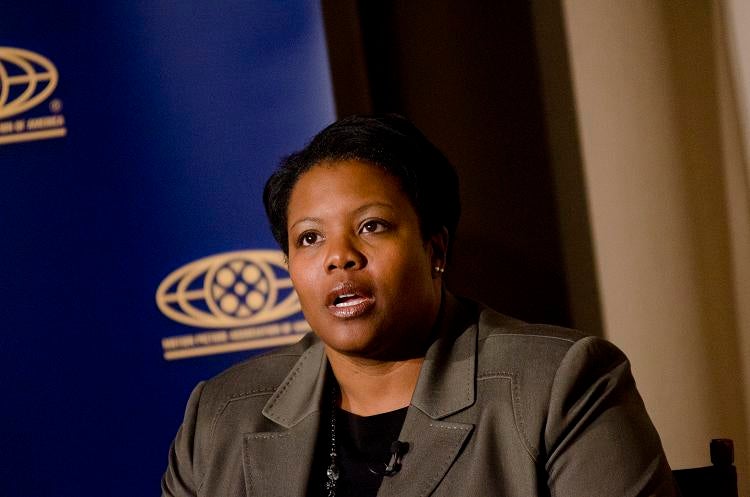Students test 'teach to one' learning system

WASHINGTON — It might seem to be a less-than-realistic plan: Put nearly 200 preteens in one large classroom space and expect each of them, with the help of laptops and a few teachers, to learn math at his or her own pace.
But that arrangement is at the core of a new instructional approach that one of the District of Columbia's lowest-performing middle schools adopted this fall.
Pioneered in New York and expanding to other cities, "Teach to One" puts a computer algorithm in charge of figuring out what each child needs to learn and do each day, a design meant to ensure that students master one concept before moving onto another.
"If it works like we think it will, it'll be a game-changer," said D.C. schools Chancellor Kaya Henderson of the new program at Hart Middle School in Southeast Washington, where less than 30 percent of students are proficient in math.
This is the leading edge of the larger "blended learning" movement that many reformers think could transform education in the United States, harnessing technology to help teachers deliver personalized lessons to every child.
The federal government is throwing its weight behind the effort, too, offering $400 million in competitive Race to the Top grants to school systems that put forth innovative plans for tailoring education for individual students.
But for all the buzz and investment, experts say there is scant evidence that such blended approaches are more effective than traditional teaching, and there are many unanswered questions about what it means for school budgets and teachers' working conditions.
And the programs don't come cheap: It cost $1 million to bring Teach to One to a single classroom at Hart Elementary this year.
Western Michigan University Professor Gary Miron, a prominent critic of full-time online schools where students learn entirely by laptop at home, said he is far more optimistic about blended programs. But he urged caution, saying each model should be tested and evaluated before it is expanded.
"I certainly think it's worth a try on a small scale to test these ideas, and be willing to back out if it doesn't work," Miron said.
The unanswered questions about blended learning are no deterrent for educators grasping for a solution to persistently low student achievement.
"To me it was a no-brainer: Very little risk and big return," said Dominick D'Angelo, principal of David Boody Jr. Junior High School in Brooklyn, N.Y., among the first three schools to try what is now Teach to One, in 2010. "I thought, 'It can't be worse than traditional instruction.' "
It's certainly louder than traditional instruction. Veteran teachers say they're not bothered by the din, reminiscent of a bustling diner at breakfast when 150 sixth-graders crowded into one room at Boody on a recent afternoon.
"You learn to tune the noise out," said Gerard Joe-Yen, a math teacher who delivered a lecture on long division that held the attention of a dozen students despite the distractions.
In Teach to One, students arriving to class receive a "playlist" of lessons to work on that day with one of the multiple teachers in the room. The students are grouped with others who are slated to learn the same skill that day.
Some huddle, working on problems together; others learn directly from teachers in a more traditional lecture-style format. And some log on to laptops to watch instructional videos and complete online work sheets.
At the end of the day, each child takes a five-question quiz. A computer program digests the results, decides whether the student is ready to move on to a new concept, and spits out a plan for the next day, regrouping students and sending them to different teachers.
Results so far have been mixed. Two of the initial three New York schools dropped the program at the end of that first year.
But Boody, where test scores hadn't budged the first year, kept at it. And the second year yielded gains. The proportion of students proficient in math on state tests grew nearly five percentage points — faster than the city average and faster than New York schools with comparable demographics.
Joel Rose and Christopher Rush developed the program as a project of the New York City Department of Education, building it around the conviction that students should be taught exactly what they need to know — a feat that many teachers say is nearly impossible in a regular classroom filled with 30 students at 30 different levels.
"There's just a serious design flaw in that model," said Rose, who left city government last year and with Rush spun off a nonprofit group to spread their concept across the country. "Each kid is unique and they have their own strengths and academic needs, and their own ways of learning and their own interests."
Teach to One has secured $13 million in foundation support and is in eight schools: five in New York, two in Chicago and at Hart in Washington, where teachers and students are adjusting to the recent change.
"There are rough patches," said Araceli Flores, one of seven math teachers at Hart, but "there are also moments when you can see it working."
Rose and Rush, who hope to expand Teach to One into new subject areas and into 50 to 100 schools over the next five years, said they're tweaking the program daily. They made substantial revisions this fall, including adding a component that gives teachers the chance to teach deeper problem-solving skills by working with the same group of students several times over two weeks.
"We don't have this all figured out yet, but we think we're on the right track," Rush said.
Join our commenting forum
Join thought-provoking conversations, follow other Independent readers and see their replies
Comments
Bookmark popover
Removed from bookmarks